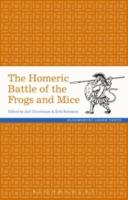
Bloomsbury (2018) h/b 198pp £85 (ISBN 9781350035942)
To get the bad news out of the way first: the commentary on the Greek text falls out of sync with the translation and commentary at l. 98 and continues increasingly to do, with the result that the Greek text finishes at l. 315 and the translation and commentary at l. 302. The reason is that the Greek text includes a number of interpolations, but the line-numbering, which was clearly done automatically, does not mark them (e.g. l. 97a, etc) and so take them into account. Bloomsbury should insert a slip to that effect.
The BFM has been dated from the 7th C BC, as a light Homeric paignion, to the Second Sophistic. C./R. plump for the later date. They summarise the content of the poem: a frog gives a mouse a ride only to dive when a water-snake appears and drown the rider; the mice declare war, both sides arm themselves and Homeric-style battle ensues; the gods decide to support neither side, but when the mice look like wiping out the frogs, Zeus sends crabs to scatter the murine forces and the fighting ends.
In their lengthy introduction, C./R. compare BFM with Aesopian fable and various styles of epic parody—e.g. the Margites and poets who use epic language for amusing effect (the mysterious Hegemon, and the various animal epics, weasels vs. mice, cranes and so on). In the absence of true comparanda, they conclude that BFM fits into no neat category. An introduction to Homeric language and metre and a heathy reading-list follow.
The commentary is based on the Greek, not the English (sometime the Greek lead entry is translated, sometimes not). It does a good job of combining grammatical and lexical linguistic help (all those amusing frog and mice names are explained) with apt literary, cultural and historical comment, especially on Homeric diction, style and typical scenes. A full Greek-English glossary and index are appended.
This admirable edition, designed for the enjoyment of those who have A-level Greek behind them, especially if they have read some Homer, is (line-numbering apart) a model of its kind and should be widely welcomed.
Peter Jones
